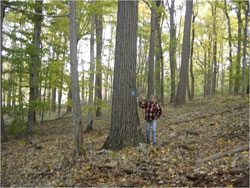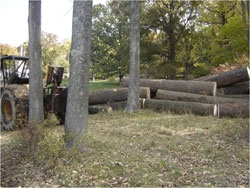Content hereThe forests of the northern half of the state contain some of the most economically important species in the eastern US. The many upland oaks, sugar maple, yellow poplar or tulip poplar, and white ash are well-valued by society and the free market. This resource, managed effectively, is renewable, sustainable, and a sink for atmospheric carbon.
However, as incredible of a resource as trees are, it is important to remember that every living thing has an expected lifespan. Many of the dominant and codominant trees in older forests are now beginning to mature and will now begin to exceed both economic and physical development.
Once maturity is reached, growth is slowed and trees become more susceptible to fungal rot, insect infestations, disease and storm damage.
A timber harvest using the individual tree selection system usually entails the harvest of approximately 7 to 9 trees per acre. At this level of removal, additional sunlight will become available to residual trees and will also allow limited additional sunlight to the understory for new trees and understory plants to grow.
A group selection harvest would work to harvest both timber and firewood within areas of ¼ acre to over an acre to allow for complete openings within the forest which would be more favorable for understory and new tree regeneration. Openings would also filter more sunlight into adjacent forested areas.
Both selection systems can be beneficial for forest health and wildlife considerations.
The income derived from a timber harvest can provide a source to fund other conservation-related activities on the property, or meet other needs of the landowner. The selection systems described above are most usually associated with uneven-aged management.
If a timber sale is agreed upon, trees would be individually marked and measured by the foresters to assure that only the necessary trees are included in the harvest. In addition, Gracie and Harrigan, Inc. should also be responsible for solicitation of bids, contract preparation, collection of timber fees and inspection of work in progress.
The economics of timber harvests may make operations on small properties unattractive to loggers.
In situations like this, foresters attempt to coordinate timber sales at adjacent or nearby properties in order to make the total sale economical and attractive for both landowner and logger.






